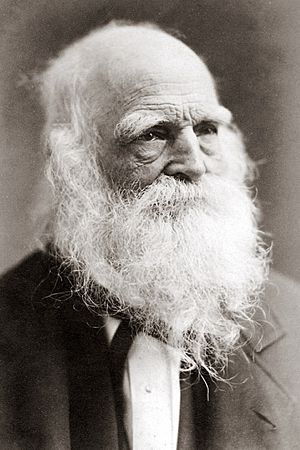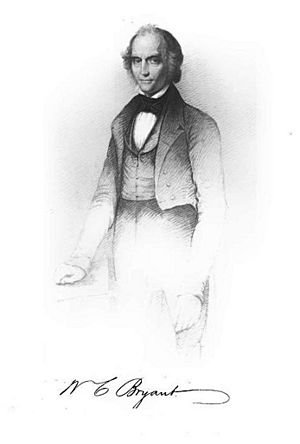William Cullen Bryant facts for kids
Quick facts for kids
William Cullen Bryant
|
|
|---|---|

Cabinet card of Bryant, c. 1876
|
|
| Born | November 3, 1794 Cummington, Massachusetts, U.S. |
| Died | June 12, 1878 (aged 83) New York City, U.S. |
| Resting place | Roslyn, New York |
| Occupation |
|
| Alma mater | Williams College |
| Notable works | "Thanatopsis" |
| Signature | |
|
|
|
William Cullen Bryant (born November 3, 1794 – died June 12, 1878) was an important American romantic poet and journalist. He was also the long-time editor of the New York Evening Post newspaper. Born in Massachusetts, he first worked as a lawyer. However, he was interested in poetry from a young age. He later moved to New York and became a newspaper editor. Bryant became one of the most famous poets in early American literature. He is often grouped with the fireside poets because his poems were easy to understand and very popular.
Contents
Biography
Early Life and Learning
William Cullen Bryant was born on November 3, 1794, in a log cabin near Cummington, Massachusetts. Today, a special plaque marks the place where he was born. He was the second son of Peter Bryant, a doctor and later a state lawmaker. His mother, Sarah Snell, had ancestors who came to America on the Mayflower ship. These included John Alden and Priscilla Mullins. Their love story was even written about in a famous poem by Henry Wadsworth Longfellow.
When William was two years old, his family moved to a new home. This house, called the William Cullen Bryant Homestead, is now a museum. Bryant went to Williams College for only one year. He wanted to go to Yale, but his family could not afford it. His father suggested he study law instead.
So, Bryant began studying law in Massachusetts. He became a lawyer in 1815. He practiced law in a nearby town, walking seven miles from his home every day. During one of these walks in December 1815, he saw a bird flying alone. This sight inspired him to write his famous poem "To a Waterfowl".
Bryant loved poetry from a young age. His father helped him learn from famous British poets. When he was young, he wrote a poem called "The Embargo" in 1808. It was a strong attack on President Thomas Jefferson. This poem sold out quickly, partly because people were amazed by how young the poet was.
First Poems
"Thanatopsis" is Bryant's most well-known poem. He might have started writing it as early as 1811. In 1817, his father found some of his son's poems. He sent them to an editor at the North American Review. The editor was very impressed. He thought, "That was never written on this side of the water!" meaning it was too good for an American to have written.
Someone at the North American Review put two parts of Bryant's poem together. They gave it the Greek name Thanatopsis, which means "meditation on death." They mistakenly thought his father wrote it. But once they knew the truth, Bryant's poems appeared regularly in the Review. A part of "Thanatopsis" is even carved into the base of the William Cullen Bryant Memorial in New York City. Another popular poem, "To a Waterfowl", was published in 1821.
On January 11, 1821, Bryant married Frances Fairchild. He was still working as a lawyer. Soon after, he was asked to give a speech at Harvard University. For this speech, he wrote "The Ages," a long poem about the history of civilization. This poem ended with the founding of the United States. He published a book of poems, also called Poems, which included "The Ages." This book helped establish him as a poet. By 1832, he was known as America's leading poet.
Working as an Editor
From 1816 to 1825, Bryant worked as a lawyer in Great Barrington, Massachusetts. This job helped him support his family. But he found it difficult and wanted a literary career. So, he moved to New York City, which had a lively cultural scene. In 1825, he started working as an editor for the New-York Review.
Later, he began working part-time for the New-York Evening Post newspaper. The main editor, William Coleman, was often sick. So, Bryant's responsibilities grew quickly. He went from assistant editor to editor-in-chief and even became a co-owner of the newspaper. The Post had been started by Alexander Hamilton.
Over the next 50 years, the Post became one of the most respected newspapers in New York City. It was a major voice for the Democratic Party and later for the Free Soil and Republican Parties. The newspaper also made Bryant quite wealthy. Even though he started with different political views, Bryant became one of the most liberal voices of his time.
He supported organized labor early on, saying that workers had the right to strike. Bryant also defended religious minorities and immigrants. He strongly supported ending slavery. He fought for human rights and spoke out against powerful bankers who tried to control the newspaper. Many historians see Bryant as a great liberal thinker.
In 1855, he was chosen as a member of the American Academy of Arts and Sciences.
Bryant had once been against Thomas Jefferson. But he later became a key supporter of the same party under Andrew Jackson. Bryant's views were always progressive. He joined the Free Soilers, and when that party became part of the new Republican Party in 1856, Bryant strongly supported John C. Frémont. In 1860, he was a main supporter of Abraham Lincoln in the East. He even introduced Lincoln at a famous speech at Cooper Union. This speech helped Lincoln become president.
Later Years

Bryant edited a very popular book series called Picturesque America. It was published between 1872 and 1874. This two-volume set had many beautiful pictures and described scenic places in the United States and Canada. In his last years, Bryant focused on translating Homer's famous works, the Iliad and The Odyssey, into English poetry. He worked on these from 1871 to 1874. He was also known for his interest in homeopathy (a type of medicine) and for writing hymns for the Unitarian Church.
In 1843, Bryant bought a house called Cedarmere in Roslyn Harbor, Long Island. He named it for the cedar trees around the pond. In 1865, he bought the farmhouse in Cummington where he grew up. He spent his summers there until he died. He made many improvements to both houses. Bryant was very careful with the trees on his land. Later in life, he worried that cutting down too many trees in the United States would harm farming.
Bryant died in 1878 after an accidental fall. He had just attended a ceremony in Central Park to honor an Italian hero named Giuseppe Mazzini. He is buried at Roslyn Cemetery in Roslyn, New York.
Legacy
Even though Bryant was born in New England, he spent most of his life in New York. He was very dedicated to the city. He was a major supporter of the idea that became Central Park. He also helped create the Metropolitan Museum of Art. He was one of the founders of New York Medical College. He was close friends with artists from the Hudson River School, especially Thomas Cole.
In 1884, Reservoir Square in New York City was renamed Bryant Park. This park is next to the New York Public Library's main building. In 1915, a statue of William Cullen Bryant by sculptor Herbert Adams was featured at a big exhibition in San Francisco. A bronze version of this statue is also in Bryant Park.
Outside New York City, the village of Roslyn Harbor, New York on Long Island has the William Cullen Bryant Preserve. This land was once owned by Bryant. The Bryant Library in Roslyn, New York, is also named after him. It is near his Cedarmere Estate.
Other places named after Bryant include a neighborhood in Seattle, Washington, and Cullen Bryant Park in Toronto, Canada. There is also the Bryant Free Library in Cummington, Massachusetts, and the Bryant House at Williams College.
Several schools are named after Bryant, including William Cullen Bryant High School in Long Island City, New York. There are also elementary schools in Milwaukee, Wisconsin, and Long Beach, California, among others.
Martin Luther King Jr. even quoted Bryant in his famous speech "Give Us the Ballot." He said, "there is something in this universe which justifies William Cullen Bryant in saying: 'Truth crushed to earth will rise again.'"
See also
 In Spanish: William Cullen Bryant para niños
In Spanish: William Cullen Bryant para niños
- Cullen, Saskatchewan and Bryant, Saskatchewan



